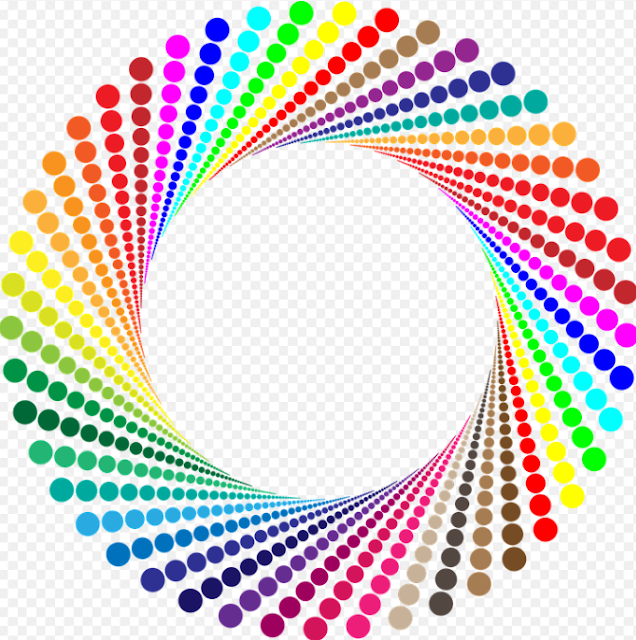THE COLOR
¿What is Color?
Color is the individual visual perception caused by light in the visible area of the human eye. Color perception is differentiated subjectively by the nature of the eyes, the sensitivity of the receptors, and the next perceptual apparatus. Other optical perceptions such as structure (shadow-light effects), brightness or roughness, as well as psychological effects and phenomena of the sense of sight, such as adjustment or adaptation, must be distinguished from the concept of color.
"Color is the facial sensation of a part of the field of vision which appears to have no structure for the human eye and which, with the observation of one eye, can distinguish this object with an immobile eye from an adjacent district, also without structure, adjacent".
Description of the color prints.
Distinction of achromatic and chromatic colors.
Colors without any color are called achromatic colors. These include white, black and grey tones.
The remaining colors are called chromatic colors, such as blue, red, yellow, etc.
How many colors can we distinguish?
Man can distinguish about 200 tones. If the intensity of the respective tone changes now, approximately 500 brightnesses are obtained per color. Finally, the proportion of white in the color is varied and receives about 20 more colors per color. In general, therefore, humans can distinguish about 20 million colors. Since this number of colors is too large to handle well, psychology is generally limited to four colors (blue, yellow, red, green). These basic colors and their combinations are sufficient to describe all distinguishable colors. If these colors are now arranged in a circle to correspond to the row in the color spectrum, then the basic colors are in positions 12, 3, 6, and 9 o'clock.
¿What are colors?
Isaac Newton provided the first clues to explain color perception from 1704. He placed a prism so that sunlight would fall through a hole in the dark window.
He observed that the sunlight was changed as it passed through the prism. And it actually split into a spectrum of colors. This process was reversible. By combining the spectral colors with the help of a lens, he managed to restore the original sunlight.
Later work showed that spectral colors differ in wavelength. Light with the wavelength of
- around 400 - 450 nm we see violet.
- 450 - 500 nm we see blue.
- 500 - 570 nm we see green.
- around 570 - 590 nm we see yellow.
- 590 - 620 nm we see orange.
- Around 620 - 700 nm we see red.
However, most of the time we do not see the light directly from the source, but the rays reach our eyes after being reflected on a surface. To understand why objects can appear colored even when illuminated by an achromatic light source, let's take a look at the reflectance curves of objects.
Psychological focus.
Color is a sensation.
Outside the eye, there are no colors but only radiations; when they reach the retina of the eye, they become nerve impulses by specific sensory cells. These impulses are transmitted to the brain and cause a sensation of color there.
The prerequisites for such a color sensation are, on the one hand, physical causes (radiation), which trigger the color stimulus, and, on the other hand, functional and sensitive sensory cells (retina), which belong to a living organism. Without these physical and biological conditions, the term "color" does not exist at all.
Consequently, color is defined as follows:
"Color is the facial sensation of a field of vision that appears to have no structure for the eye, and which, with the observation of one eye, can distinguish this part with the immobile eye from an adjacent, unstructured, contiguous region. (according to DIN 5033, part 1 - 9: color measurement (1964 - 1978))
According to that definition, color is a facial sensation. However, since seeing is perceived differently than color, the concept of facial sensation should be limited:
"Without structure" refers to the fact that two objects compared to each other should not be distinguished by a texture such as grooves.
"The observation of an eye with the naked eye" refers to the perception of brightness. Brightness is a phenomenon of contrasting brightness that arises when the same field of vision at the same time has a noticeably different brightness for both eyes (or an eye in rapid succession). As long as we observe a fixed surface with one eye still, we do not perceive any brightness.
The psychological approach to color perception shows that color is a subjective sensory experience.
¿How do we perceive colors?
Trichromatic Theory
This theory by Young and Helmholtz states that color perception is based on three types of receptors, each of which has a different spectral sensitivity. Light with a certain wavelength stimulates the three types of receptors differently, and the pattern of activity triggers a sense of color in the brain.
Young and Helmholtz based their theory on a series of experiments called "color matching. In these experiments, the Vpn is to adjust the proportions of three wavelengths so that the color of the mixture and the comparative color, which consists of a single wavelength, look identical.
For example, a light of 500 nm will be generated by mixing the wavelengths 420 nm, 560 nm and 640 nm.
(0.5 * 420nm + 0.375 * 560nm + 0.125 * 640nm = 500)
In this way, each wavelength and therefore each color can be generated. To mix, any of the three wavelengths can be used as long as they are independent of each other; that is, if none of the three wavelengths can be generated by mixing the other two.
Gegenfarbentheorie
Although the Trichromatic Theory explains a variety of phenomena that occur in color perception, such. Like color mixing, there are some color perceptions that cannot be explained by it. This has Herring (1878) explains with the help of his theory of opposite colors. He discovered that the pairs of colors belong together red and green or blue and yellow. She based her theory on a series of experiments, as well as on the fact that people who cannot see red cannot perceive green either (also blue and yellow). The basic idea of the theory are three mechanisms that react in opposite ways to different intensities of light:
- The black (+) white (-) mechanism reacts negatively to dark light and positively to white light.
- Red (+) green (-) mechanism responds positively to red and negative to green.
- The yellow (+) - blue (-) mechanism reacts positively to yellow and negative to blue.
Color is safe
The beauty of color is that it is the part of this energy spectrum that is most in tune with our frame. It is the part of the spectrum to which we have the greatest sensitivity, the part that does us the least harm. Like Vicky Wall, the founder of Aura-Soma used to like to see that we are human beings.
White represents the seven colors of the spectrum: red, orange, yellow, green, blue, anil and violet. The color black is the absence of color or absence of light.
The term "color" is applied in different contexts. It can refer to the color of the hair, the color of the eyes or the color of the skin. In the latter case, the expression "colored" indicates someone with dark skin tone.
In the figurative sense, "to remain without color" expresses the sudden pallor of an individual due to a fright, illness or emotion. "Changing color" may indicate paleness or blushing of the skin.
In various popular expressions the term comes up, for example:
- giving color to life" refers to a change of attitude of someone who wants to live more intensely, with more joy;
- color of donkey when it runs away" means an indefinite color.
- Not seeing the color of money" may indicate a calotte suffered by someone or not having financial resources.
Meaning of Colors
Colors have different meanings that vary between different cultures. In Western culture, colors are related to human emotions. They can also assume different functions, for example, through the standardized colors of traffic lights.
In the decoration of environments, the stimulating effect of colors is not neglected, nor is the energetic effect, which, through chromotherapy, influences people's health.
Colors have been agreed to symbolise certain events or sensations, for example, red symbolises war, green symbolises hope and white symbolises peace.
Learn more about the meaning of colors.
Uses of color
The color is extremely versatile in its applications. It can be used to make a statement, create an atmosphere or request a response. Color expresses itself toward the world, but it also helps us travel toward spiritual states, toward our true self. We can use color to get what we want from the world, or we can use it to find something in ourselves.
Fashion
In fashion, the cut and style of our clothes will express our values, but it is the color that will add the personal touch, showing something of our personality or our current state.
Decoration
In decoration, color will create an atmosphere, in a public space that means saying or doing something to others. For example, green in the hospital ward, yellow in the nursery. At home, colors are a way of nourishing ourselves. Particularly when we move to more private areas of the house, such as our room. We choose colors that make us feel good, relaxed, nourished, revived or optimistic, whatever we want.
Business
In business, color can be used to achieve desired results. Blue is good for suits (and for the police). It seems authoritarian, in fact it relates to the throat chakra, which is the energy for the leader, the one who uses his voice to give instructions. Surprisingly, it is also used for the workers' monkey. The workers are not leaders, but in this case, besides not making too much mess, the blue can keep the workers aligned with the influence of the leader (blue). Workers in red overalls could be stimulated by red to rebel instead, red is the color that stimulates "Stop", "No" and Revolution!
Marketing and Design
In marketing and design, color can help support a message, green says fresh for vegetables (but not for meat!). Red says exciting, sexy. Gold (not too much) says quality. Associations for each color play a vital role here, however they must also be modified for local cultural considerations. For example, black is for funerals in the West, but white is used in China.
Art and Culture
In the world of art and high culture, color plays an important symbolic role. In Christian art, for example, the Virgin Mary typically appears in blue and white. These colors say heavenly (blue sky) and pure (white). She was a virgin, sexually (red) inactive. Her son Jesus as the Christ typically appears in red and white. White for purity again but red here is for action, committing to the earth and life on it. Jesus did not stay on the mountain meditating. He led a spiritual revolution in society.
The language of color
Color communicates
The clothes we wear, the colors in which we surround ourselves, say something about ourselves. Designers and artists understand this and use color to make statements. Over time, these statements can evolve into a symbolic language within the history of that system. Thus, in Christian religious art, for example, white may represent purity. This is a very formal level at which one can say that color is a language.







Comentarios
Publicar un comentario